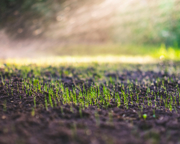Yates Account
Join now
Create a Yates account today!
Sign up to join the Yates Garden Club for monthly e-mails packed with seasonal inspiration, tips for success & exclusive promotions.
Plus if you’re a Garden Club member you can take part in the Yates Growing Community - a blog to share successes, get advice & win prizes in fun challenges along the way!

Forgot password
Enter the email address associated with your account, and we'll email you a new password.
Yates Lawn Fertiliser for New Lawns is designed to give your new lawn the right nutrients to encourage fast establishment of new grass, while feeding for up to 12 weeks.
How does it work?
Formulated specifically for establishing new lawns that need gentle fertilising - so that delicate young grass isn't damaged. Too much fertiliser on a new lawn can shock or harm the grass, or even kill it. Yates Lawn Fertiliser for New Lawns has been developed with the right blend of slow-release nutrients to gently kickstart your lawn.
Features
- Slow release Nitrogen gives lawn seed a great start, without burning
- Rich blend of ingredients to boost germination and strong root development
- Natural seweed biostimulant helps reduce lawn stress
- Humic acids stimulate beneficial microbes, to boost soil health
- Iron, Magnesium and trace elements for a deep green colour
- Natural wetting agent to boost water penetration into soil (*limited benefit to heavy clay soils)
- Methylene urea formula reduces leaching into groundwater
Application Rate
Apply 15g per square metre (m2). One handful is approximately 40g (guide only).
When to Apply
For best success when growing new lawns, establish in early autumn or early spring.
How to Apply
- Prepare Ensure the soil is well prepared by removing weeds, unwanted rocks and debris. Level the ground evenly with a rake. Water the area.
- Measure the ground area and calculate the amount of Yates Lawn Fertiliser for New Lawns required.
- Spread Using a sweeping arc motion, spraed evenly at the recommended rate. In a criss-cross fashion, spread half the amount required walking in one diagonal direction and the remainder from the opposite direction.
- Sow Evenly spread lawn seeds onto soil, following directions on the lawn seed packaging carefully.
- Water Always water in well immediately after application.
Handy Tips for Best Results
Weather
Apply during fine weather, avoiding windy conditions and heavy rain. DO NOT APPLY if maximum temperature exceeds 30°C or when soil is dry, or lawn is moisture stressed.
Water
Ensure lawns or prepared soil area is well watered before and after application of the fertiliser. If hot conditions are expected following application, ensure you water well.
Soil Health
Ideal lawn soil pH is between 6-7. Apply Yates Thrive Natural Garden Lime to adjust soil pH if it is too acidic (below 6).
| Size |
3Kg |
| Ingredients |
NPK: 4.3: 0.1: 2.8 + Te (approx. 25% as slow release Nitrogen). |
DANGER
Contains: <10% Methylene urea
May cause an allergic skin reaction. May cause allergy or asthma symptoms or breathing difficulty if inhaled.
PRECAUTIONS
Keep out of reach of children. Read carefully and follow all instructions. Avoid breathing dust, fumes, gas, mist, vapours or spray. Contaminated work clothing must not be allowed out of the workplace. Wear protective gloves/protective clothing including eye/face protection. In case of inadequate ventilation wear respiratory protection.
FIRST AID
If medical advice is needed, have product label or container at hand.
IF ON SKIN: Wash with plenty of water and soap.
IF INHALED: If breathing is difficult, remove victim to fresh air and keep at rest in a position comfortable for breathing.
IF SKIN IRRITATION OR RASH OCCURS: Get medical advice/attention
IF EXPERIENCING RESPIRATORY SYMPTOMS: Call NATIONAL POISONS CENTRE (0800 764 766) or doctor/physician. Wash contaminated clothing before reuse.
FOR EMERGENCIES ONLY CALL: 0800 734 607 (24 HOURS)






















Share
Share this product on social media